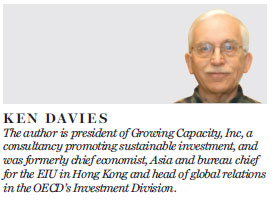HK's vital role in Belt and Road
Updated: 2016-05-17 08:09
By Ken Davies(HK Edition)
|
|||||||||
Ken Davies writes that the visit of Zhang Dejiang marks the moment the SAR's political and business leaders should commit themselves to the latest national development plan
Beijing's top official in charge of policy toward Hong Kong, Zhang Dejiang, is set to participate in a summit on the country's Belt and Road program in Wan Chai on Wednesday. This marks an opening for Hong Kong to take an increasing role in the country's development; it will be up to Hong Kong's business sector to take up the challenge.
Zhang is chair of the Standing Committee of the National People's Congress and, more importantly, a member of the Politburo Standing Committee of the Communist Party of China. He is exactly the right person to talk about Belt and Road in Hong Kong at this juncture, as he has a unique combination of experience as a former governor of Guangdong, pioneer of the Greater Pearl River Delta cross-province initiative (including Hong Kong), and troubleshooter.
While media attention is already focused on a probable meeting between Zhang and local politicians, he is not likely to take sides in local disputes, but can be relied upon to stress the benefits to Hong Kong of even closer economic links to the mainland. This is a shrewd move by the central government, stressing the positive aspects of the relationship and refusing to be drawn into unnecessary controversy.
The timing of this summit is also appropriate: Hong Kong's economy is currently in the doldrums. The total number of visitors arriving in Hong Kong was 10.9 percent lower in the first quarter of 2016 compared to a year earlier, largely because of a 15.1 percent drop in those from the mainland, who make up three-quarters of all visitors, according to latest figures from the Hong Kong Tourism Board. The government's own economic forecast, in the February Budget, is for GDP growth of only between 1 and 2 percent for the whole of 2016.
President Xi Jinping launched the Belt and Road Initiative in 2013. "Belt" refers to the Silk Road Economic Belt, extending westward from China across Eurasia. "Road" is the 21st Century Maritime Silk Road stretching eastward from China right across to the Mediterranean.
Xi's aim is to strengthen economic collaboration between all the countries in the two groupings, which have already responded positively.
In January, Chief Executive Leung Chun-ying's policy address contained a whole section outlining Hong Kong's projected role in the Belt and Road program. Hong Kong has, he said, "strong complementarity with the Belt and Road countries, and great potential to create synergy with them".
There may be some skepticism in Hong Kong about all this in view of the lackluster record of the last such initiative, Hong Kong's contribution to the "Go West" program announced by the SAR's first chief executive, Tung Chee-hwa, in 1999. This fizzled out shortly after then chief secretary for administration Donald Tsang Yam-kuen led a delegation of 282 business people, including 71 CEOs, to tour Western China in 2001. You may well ask: How is this any different?
Since 2000, China has been transformed from being one of the world's top destinations for foreign direct investment (FDI) to being one of the largest providers of FDI to other countries. Many Chinese companies now have experience of investing abroad.
During this time, there has been a huge infrastructure investment splurge in China's hinterland, designed to reduce the burgeoning income disparity with the more developed eastern coastal regions and to maintain national economic growth in the wake of the 2008-09 global economic crisis.
Most recently, China has established the BRICS New Development Bank (NDB), the Asian Infrastructure Investment Bank (AIIB), and the Silk Road Fund, which together will provide $100 billion for infrastructure funding in Asia.
What does all this add up to?
China is providing an institutional foundation for promoting joint development across a swathe of Central Asia. This appears to be taken seriously even by needy countries further afield, such as Greece. And it is putting its money where its mouth is. The objectives of Belt and Road are grandiose, but limited in scope, so they are achievable. The program will bring benefits to China as its own economic growth model changes gear.
Hong Kong's role in these initiatives has yet to be properly thought out.
The initial opening-up of the Chinese mainland in the 1980s and 1990s was done largely through Hong Kong, as labor-intensive export manufacturing came to dominate the mainland's economy. China's turn to the West, embodied in both the "Go West" and Belt and Road programs, marks a geographical shift in economic policy that presents a challenge to Hong Kong.
Just as it has had to adapt to the evolution of infrastructure and institutions on the mainland, Hong Kong will now have to find its own niche in Belt and Road. The SAR government can lead delegations to survey the landscape in the Central Asian countries and elsewhere, but at the end of the day businesses will decide for themselves if, where and when to invest. The government can best help by collecting and disseminating as much information as it can, and then getting out of the way.

(HK Edition 05/17/2016 page10)